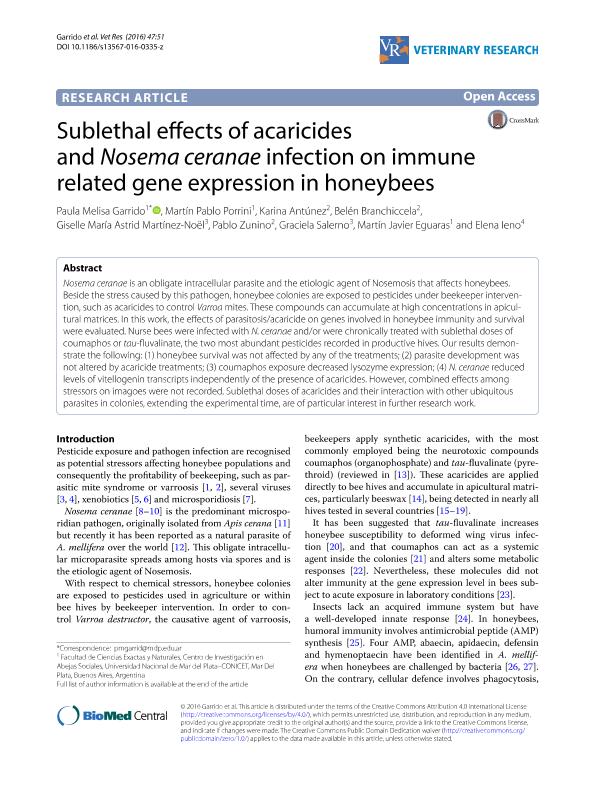Artículo
Sublethal effects of acaricides and Nosema ceranae infection on immune related gene expression in honeybees
Garrido, Paula Melisa ; Porrini, Martín Pablo
; Porrini, Martín Pablo ; Antúnez, karina; Branchiccela, Belén; Martínez Noël, Giselle María Astrid
; Antúnez, karina; Branchiccela, Belén; Martínez Noël, Giselle María Astrid ; Zunino, Pablo; Salerno, Graciela Lidia
; Zunino, Pablo; Salerno, Graciela Lidia ; Eguaras, Martin Javier
; Eguaras, Martin Javier ; Ieno, Elena
; Ieno, Elena
 ; Porrini, Martín Pablo
; Porrini, Martín Pablo ; Antúnez, karina; Branchiccela, Belén; Martínez Noël, Giselle María Astrid
; Antúnez, karina; Branchiccela, Belén; Martínez Noël, Giselle María Astrid ; Zunino, Pablo; Salerno, Graciela Lidia
; Zunino, Pablo; Salerno, Graciela Lidia ; Eguaras, Martin Javier
; Eguaras, Martin Javier ; Ieno, Elena
; Ieno, Elena
Fecha de publicación:
26/04/2016
Editorial:
EDP Sciences
Revista:
Veterinary Research
ISSN:
0928-4249
e-ISSN:
1297-9716
Idioma:
Inglés
Tipo de recurso:
Artículo publicado
Clasificación temática:
Resumen
Nosema ceranae is an obligate intracellular parasite and the etiologic agent of Nosemosis that affects honeybees. Beside the stress caused by this pathogen, honeybee colonies are exposed to pesticides under beekeeper intervention, such as acaricides to control Varroa mites. These compounds can accumulate at high concentrations in apicultural matrices. In this work, the effects of parasitosis/acaricide on genes involved in honeybee immunity and survival were evaluated. Nurse bees were infected with N. ceranae and/or were chronically treated with sublethal doses of coumaphos or tau-fluvalinate, the two most abundant pesticides recorded in productive hives. Our results demonstrate the following: (1) honeybee survival was not affected by any of the treatments; (2) parasite development was not altered by acaricide treatments; (3) coumaphos exposure decreased lysozyme expression; (4) N. ceranae reduced levels of vitellogenin transcripts independently of the presence of acaricides. However, combined effects among stressors on imagoes were not recorded. Sublethal doses of acaricides and their interaction with other ubiquitous parasites in colonies, extending the experimental time, are of particular interest in further research work.
Palabras clave:
Apis Mellifera
,
Acaricides
,
Nosema Ceranae
,
Sublethal Doses
Archivos asociados
Licencia
Identificadores
Colecciones
Articulos(CCT - MAR DEL PLATA)
Articulos de CTRO.CIENTIFICO TECNOL.CONICET - MAR DEL PLATA
Articulos de CTRO.CIENTIFICO TECNOL.CONICET - MAR DEL PLATA
Articulos(INBIOTEC)
Articulos de INSTITUTO DE INV. EN BIODIVERSIDAD Y BIOTECNOLOGIA
Articulos de INSTITUTO DE INV. EN BIODIVERSIDAD Y BIOTECNOLOGIA
Citación
Garrido, Paula Melisa; Porrini, Martín Pablo; Antúnez, karina; Branchiccela, Belén; Martínez Noël, Giselle María Astrid; et al.; Sublethal effects of acaricides and Nosema ceranae infection on immune related gene expression in honeybees; EDP Sciences; Veterinary Research; 47; 51; 26-4-2016; 51-60
Compartir
Altmétricas



